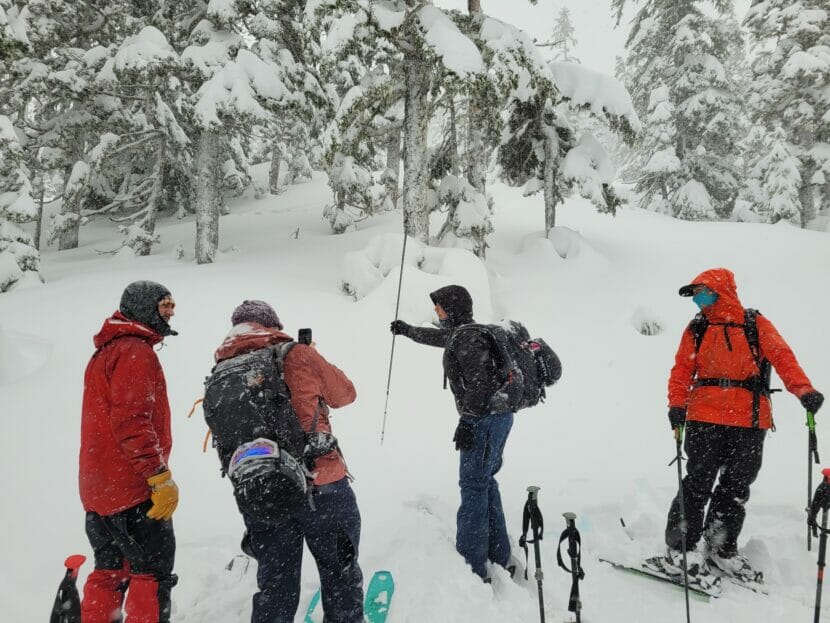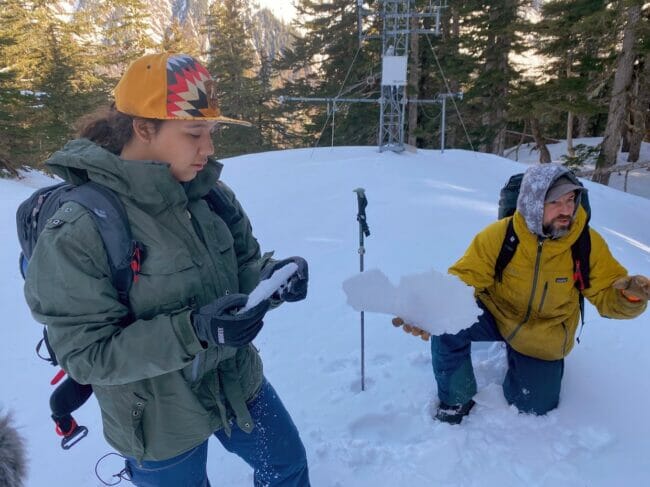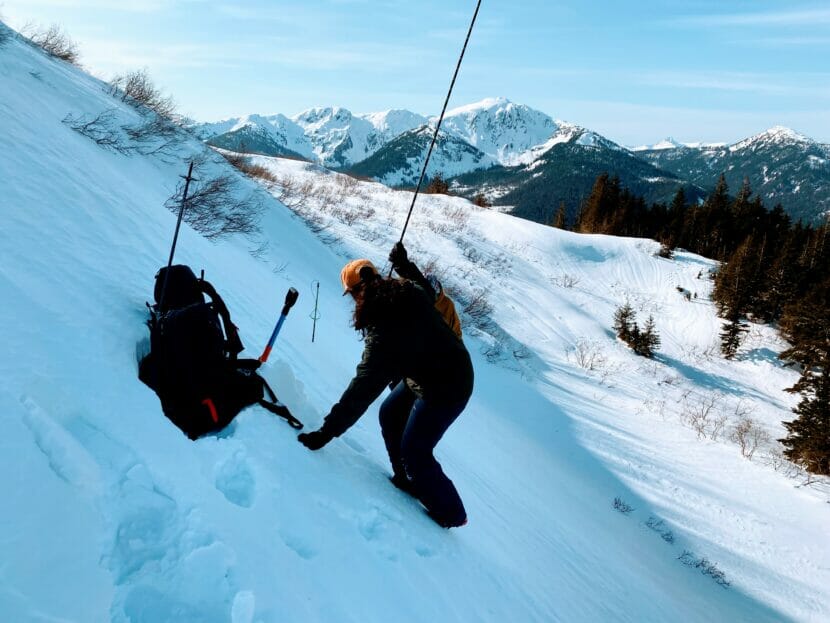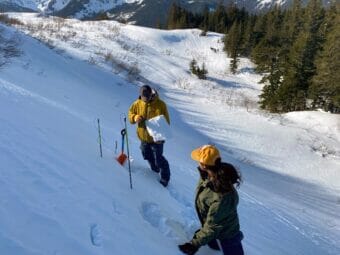
On a sunny day on top of Mount Roberts, Mike Janes pulled a snow probe out of his backpack. He snapped its segments together like a tent pole until it stood about 9 feet tall, then he handed it to Jossline Aranda-Jackson, who plunged it into the snowpack.
“You feel the different layers,” Janes said. “There might be hard crusts, there might be soft layers, or might be wet layers. You can actually feel a lot of that.”
Aranda-Jackson looked back at Janes as she hit a stubborn layer.
“My guess is that that’s the January layer, where there was a whole bunch of rain,” she said.
“Give that another tap,” Janes said. “I’m wondering.”
Suddenly the probe plunged deeper, until the whole thing was buried. Aranda-Jackson’s smile widened in surprise as she knelt down to read the measurement.
The many sensors of snow science
Aranda-Jackson is the first snow science and avalanche forecasting intern for Sealaska Heritage Institute. She has spent the winter learning how to interpret each layer of snowpack.
The program is a new addition to an existing suite of summer internships that aim to introduce Alaska Native and Native American high school students to careers in science, technology, engineering, art and math through paid work experience.

A focus on avalanche forecasting makes sense for Juneau, which is one of the most avalanche-prone cities in the United States. Alaska Electric Light & Power runs a regular avalanche forecasting program to monitor and protect local electric utilities. Janes in a part of that program.
During her free periods at school, Aranda-Jackson heads out into snowy terrain with Janes and other members of the AEL&P team to learn the complicated process of avalanche forecasting. It starts with an extensive data collection.
After they finished measuring snow depth with the probe, Janes and Aranda-Jackson turned their attention to a tall metal weather tower just a few feet ahead of them. It holds all kinds of sensors that measure the key factors that shape avalanche events.
A mounted bucket melts and measures the snowfall to give an idea of total precipitation. A sensor that looks like a string of white beads buried in the snow reads the temperature at each layer in the snowpack. A ribbed metal box measures humidity and temperature.

“And you can actually feed this weather data into a snowpack model, and it will build what it thinks the snowpack should look like,” Janes said.
Past summer interns have worked with the Alaska Department of Fish and Game, NOAA Fisheries and AEL&P, where Janes works as an avalanche forecaster.

When he approached Sealaska Heritage Institute about adding a winter internship, the program coordinators said they had the perfect candidate in mind.
Aranda-Jackson is a senior at Juneau-Douglas High School: Yadaa.at Kalé and an alumna of SHI’s science summer camps. Over the years, the program coordinators caught on to her preference for winter.
“I was always talking about how I really — I’d rather be skiing,” Aranda-Jackson said. “Kind of like, my mind was elsewhere.”
The opportunity to ski is what first drew her to the internship. Aranda-Jackson has been skiing at Eaglecrest Ski Area since she was a kid. She says she’s always been aware of avalanches, but doing fieldwork this winter has made her think more deeply about them.
“Back when I had no fieldwork in avalanche work, it was more like, ‘Oh, it’s just an avalanche. Like, okay, cool,’” she said. “But there’s so many different tools that can help you predict them, snow coverage and all that kind of stuff.”
Beyond the data
One of Aranda-Jackson’s major objectives is to learn how to collect and interpret that data. But SHI’s approach aims to go beyond data collection, to break down barriers between Western science and Indigenous knowledge and identity.
That’s where the program’s mentorship component can help. Aranda-Jackson’s mentor is Ellen Bradley, a Lingít climate scientist and semi-professional skier.
“A lot of our mentorship meetings have been out in the field while we’re working on her internship, which means a lot of it is skiing,” Bradley said. “I think that’s the most ideal way for me to be a mentor.”
SHI’s science programming aims to help students to build a deeper understanding of and commitment to their Indigenous perspectives before entering Western academic settings.
Bradley says she feels she could have benefited from something like this when she first started her education in climate science.
“I wish that was something that I would have had access to when I was in high school,” she said. “I think it would have really helped me center myself and my identity in the work that I do within STEM.”
The program also aims to remove economic barriers for pursuing physical sciences. That’s especially important for avalanche science, which demands expensive equipment like backcountry gear and high-tech snow probes — things that most students couldn’t get in their standard high school science programs.
“So I think that that’s such a cool element of this internship is that our youth are getting access to these kinds of activities in a safe and affordable way,” Bradley said.
In the fall, Aranda-Jackson will head to the University of Montana to hit new ski slopes and study glaciology. She first got interested in the field after watching the Mendenhall Glacier, and it offers the possibility for skiing in the summertime.
But with the success of the first SHI avalanche and snow science internship, another student will likely take over next winter.
